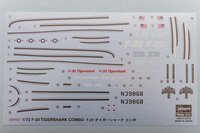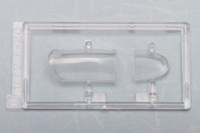
Hasegawa 1/72 F-20 Tigershark Combo
By Chris Banyai-Riepl
Overview
The Northrop F-20 was an evolution of the F-5, and was designed as a private venture to fit the DoD FX Project. By changing the twin engines of the F-5 with a single engine and incorporating new and powerful avionics and radar, the F-20 was a potent fighter on par with the F-16. The FX Project was for creating a fighter aircraft that could compete with the latest Soviet aircraft, but not use sensitive new USAF technologies. Thus the FX aircraft could be sold to foreign countries, which gave Northrop high hopes for the F-20 as many of those nations flew the F-5. Changes in policy following Reagan's election, though, pitted the F-20 against the F-16 internationally, and without US sales, the F-20 was doomed. Two of the F-20 prototypes crashed, while one survived and is currently on display at the California Science Center.
The Kit
 Hasegawa's F-20 kit dates from the 1980s, making it timely to the original F-20. Now, though, it is more dated. Still, it is a popular subject for what if modelers, and given its competition with the F-16, just about any current F-16 operator could conceivably have been flying the F-20. This latest release from Hasegawa puts two of their F-20s in one box, and pads it with a nice decal sheet providing markings for a couple of the prototypes.
Hasegawa's F-20 kit dates from the 1980s, making it timely to the original F-20. Now, though, it is more dated. Still, it is a popular subject for what if modelers, and given its competition with the F-16, just about any current F-16 operator could conceivably have been flying the F-20. This latest release from Hasegawa puts two of their F-20s in one box, and pads it with a nice decal sheet providing markings for a couple of the prototypes.
 Although an older kit, this one does feature recessed panel lines, a simple yet complete interior, and some added external bits like fuel tanks and a ladder. The instructions are clear, and the overall construction suggests that this model could be built fairly quickly out of the box. The cockpit has a one-piece tub and separate instrument panel, both of which receive decal details. The seat has separate actuator arms for displaying the canopy open, and there is a rather well done pilot figure.
Although an older kit, this one does feature recessed panel lines, a simple yet complete interior, and some added external bits like fuel tanks and a ladder. The instructions are clear, and the overall construction suggests that this model could be built fairly quickly out of the box. The cockpit has a one-piece tub and separate instrument panel, both of which receive decal details. The seat has separate actuator arms for displaying the canopy open, and there is a rather well done pilot figure.
With the cockpit done, the next step is to button up the fuselage. The intakes are separate, with separate splitter plates. Also separate is the top of the nose with the cannon barrels, which results in some good detail but the more fastidious might want to try replacing those with metal tubing.
 The remaining construction is very fast, as the stabilizers and wings solid pieces. This results in very few seams that might need to be filled. On the underside, the speed brakes are separate, and the landing gear is detailed, with separate main gear doors and wheels, although the nose gear is molded as one piece, integrating the wheel and small gear door. The kit comes with three fuel tanks and Sidewinder missiles for the wingtips.
The remaining construction is very fast, as the stabilizers and wings solid pieces. This results in very few seams that might need to be filled. On the underside, the speed brakes are separate, and the landing gear is detailed, with separate main gear doors and wheels, although the nose gear is molded as one piece, integrating the wheel and small gear door. The kit comes with three fuel tanks and Sidewinder missiles for the wingtips.
 The decal options provide markings for two of the prototypes. The first one is the example that was at the 1983 Paris Air Show. This scheme is the most colorful F-20 scheme, in red, white, and black. The decals provide the black stripes for most of the scheme, with the tail stripes also incorporating the white band. The second scheme is the second prototype from 1985, and it was finished in an overall gray scheme. The decals are nicely done, with excellent register even in the small American flag.
The decal options provide markings for two of the prototypes. The first one is the example that was at the 1983 Paris Air Show. This scheme is the most colorful F-20 scheme, in red, white, and black. The decals provide the black stripes for most of the scheme, with the tail stripes also incorporating the white band. The second scheme is the second prototype from 1985, and it was finished in an overall gray scheme. The decals are nicely done, with excellent register even in the small American flag.
Conclusion
 This is a nice little kit that has some great potential for what-if subjects as well as the actual prototype examples. With two in a box, this release is an affordable way to stock up for your F-20 needs. My thanks to Hasegawa USA for the review sample.
This is a nice little kit that has some great potential for what-if subjects as well as the actual prototype examples. With two in a box, this release is an affordable way to stock up for your F-20 needs. My thanks to Hasegawa USA for the review sample.
